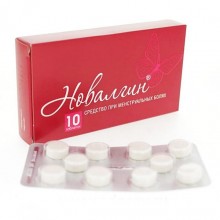



Combined drug, whose action is determined by the components that make up its composition. Paracetamol and propifenazone have an analgesic and antipyretic effect. Caffeine has psychostimulant (stimulates the psychomotor centers of the brain), analeptic action, eliminates drowsiness and fatigue, increases physical and mental performance. The action begins 15-30 minutes after administration.
- treatment of pain syndrome of low and medium intensity with primary dysmenorrhea (painful menstruation in the absence of organic changes from the genital organs);
- pain syndrome of weak and medium intensity of various genesis: headache, migraine, toothache, arthralgia, myalgia;
- febrile syndrome (as a febrifuge).
- paracetamol 200 mg
- propifenazone 200 mg
- caffeine 50 mg
No customer reviews for the moment.
Orally, after eating, with a small amount of liquid. Adults take 1-2 pills 1-4 times a day. The daily dose should not exceed 6 pills. Children from 12 to 18 years old on a tablet up to three times a day.
The duration of treatment is no more than 3 days as an antipyretic and no more than 5 days as an anesthetic.
Dizziness, sleep disturbance, palpitations, nausea, vomiting, heaviness and discomfort in the stomach, leukopenia, agranulocytosis, hemolytic anemia, methemoglobinemia, allergic reactions.
In the event of adverse reactions, be sure to consult with your doctor about the further intake of the drug.
- severe hepatic and / or renal failure;
- deficiency of glucose-6-phosphate dehydrogenase;
- inhibition of bone marrow hematopoiesis (leukopenia, anemia, including hemolytic);
- acute hematoporphyria;
- complete or incomplete combination of bronchial asthma, recurrent nasal polyposis and paranasal sinuses and intolerance to acetylsalicylic acid, or other nonsteroidal anti-inflammatory drugs (including a number in history);
- conditions accompanied by respiratory depression;
- intracranial hypertension;
- acute myocardial infarction;
- arrhythmias, arterial hypertension;
- alcohol intoxication;
- glaucoma;
- pregnancy, lactation;
- children's age up to 12 years;
- Lactase deficiency;
- lactose intolerance;
- glucose-galactose malabsorption;
- hypersensitivity to the drug.
With caution: gastric ulcer and duodenal ulcer (in acute stage), advanced age, moderate liver or kidney dysfunction, bronchial asthma.
Paracetamol reduces the effectiveness of uricosuric drugs.
The simultaneous use of paracetamol in high doses increases the effect of anticoagulants (reduced synthesis of procoagulant factors in the liver).
Inducers of liver microsomal enzymes, ethanol and hepatotoxic drugs increase the production of hydroxylated paracetamol metabolites, which makes it possible for severe intoxication to develop even with a small overdose.
Prolonged use of barbiturates reduces the effectiveness of paracetamol.
With simultaneous use with ethanol increases the risk of developing acute pancreatitis.
Myelotoxic agents increase the hematotoxicity of paracetamol.
Caffeine is an adenosine antagonist (large doses of adenosine may be required). With simultaneous use of caffeine and inducers of liver microsomal enzymes, it is possible to increase metabolism and increase caffeine clearance; inhibitors of microsomal liver enzymes - a decrease in caffeine metabolism in the liver.
Meksiletin reduces the excretion of caffeine to 50%; Nicotine increases the rate of caffeine excretion.
Monoamine oxidase inhibitors, furazolidone, procarbazine and selegiline - large doses of caffeine can cause the development of dangerous arrhythmias of the heart or pronounced. increase blood pressure.
Caffeine reduces the absorption of calcium from the gastrointestinal tract; reduces the effect of narcotic and hypnotic drugs; increases the excretion of lithium preparations with urine; accelerates absorption and enhances the action of cardiac glycosides, increases their toxicity.
Simultaneous use of caffeine with β-blockers may; lead to mutual suppression of therapeutic effects; with β-adrenomimetics - to additional stimulation of the central nervous system and other additive: toxic effects.
Caffeine can reduce the clearance of theophylline and, possibly, other xanthines, increasing the possibility of additive pharmacodynamic and toxic effects.
Propifenazone can enhance the action of oral: hypoglycemic agents, sulfa drugs, anticoagulants, the ulcerogenic effect of glucocorticosteroids, reduces the effectiveness of potassium-sparing diuretics.
The absorption of the components of the drug may be reduced when used simultaneously with Kolestiramine, m-anticholinegic, antidepressants.
Use during pregnancy and lactation is contraindicated.
Excessive consumption of caffeine-containing foods during treatment may cause symptoms of caffeine overdose.
At the time of treatment, you must refuse to take alcohol.
Influence on ability to drive motor transport and control mechanisms
During the period of taking the drug, care should be taken when driving and engaging in other activities that require increased concentration and psychomotor speed.
For paracetamol
Symptoms: during the first 24 hours after administration - pallor of the skin, nausea, vomiting, anorexia, abdominal pain; violation of glucose metabolism, metabolic acidosis. Symptoms of impaired liver function may appear 12-48 hours after an overdose. In severe overdose - liver failure with progressive encephalopathy, coma, death (10 g in terms of paracetamol or 50 pills of the drug); acute renal failure with tubular necrosis (including in the absence of severe liver damage); arrhythmia, pancreatitis.
Treatment: the introduction of SH-group donators and precursors of the synthesis of glutathione - methionine within 8-9 hours after overdose and acetylcysteine - within 8 hours. The need for additional therapeutic measures (further introduction of methionine, intravenous administration of acetylcysteine) is determined depending on the paracetamol concentration in the blood, as well as from the time elapsed after its reception.
For caffeine
Symptoms: gastralgia, agitation, anxiety, restlessness, confusion, delirium, dehydration, tachycardia, arrhythmia, hyperthermia, frequent urination, headache, increased tactile or pain sensitivity, tremor, or muscle twitching; nausea and vomiting, sometimes with blood; tinnitus,
convulsions (with acute overdose - tonic-clone).
Caffeine in doses of more than 300 mg / day (including against the background of the abuse of coffee - more than 4 cups of natural coffee, 150 ml each) can cause anxiety, tremor, headache, confusion, extrasystole.
Treatment: gastric lavage, if caffeine was taken in the last 4 hours at a dose of more than 15 mg / kg and there was no vomiting caused by caffeine; taking Activated charcoal, laxatives; in hemorrhagic gastritis - the introduction of antacids, gastric lavage with ice cold 0.9% sodium chloride solution; maintaining ventilation and oxygenation; for convulsions, intravenous diazepam, phenobarbital or phenytoin; maintaining fluid and salt balance.
Studies and clinical trials of Novalgin (Click to expand)